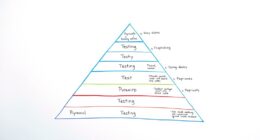Threat modeling in QA helps you catch security flaws early by analyzing system architecture, data flows, and user interactions. It allows you to identify attack vectors like injection flaws or authentication weaknesses before they turn into major issues. By simulating attack scenarios and evaluating security controls, you can prioritize fixes and integrate security checks throughout development. Continuing with this approach will reveal how to strengthen your defenses and stay ahead of emerging threats.
Key Takeaways
- Integrate threat modeling into QA to identify potential vulnerabilities during early testing phases.
- Conduct comprehensive risk assessments of system architecture and data flows to uncover security gaps.
- Simulate attack scenarios to validate security controls and detect vulnerabilities before release.
- Use threat modeling to prioritize security testing efforts based on identified risks and attack vectors.
- Continuously update threat models with new features and security products for proactive flaw detection.

Have you ever wondered how to identify potential security risks in your QA processes before they become major issues? The key lies in effective threat modeling, which helps you anticipate vulnerabilities and prevent security breaches. When you start with a thorough risk assessment, you gain a clear understanding of where your application might be exposed. This process involves analyzing your system’s architecture, data flows, and user interactions to pinpoint weaknesses before they’re exploited. By proactively identifying these risks, you can prioritize security measures that address the most critical vulnerabilities early in development.
Performing an extensive risk assessment is your first step toward solid threat modeling. It requires you to examine every component of your application—servers, APIs, third-party services, and user interfaces—and evaluate how they might be compromised. Ask yourself what data could be targeted by malicious actors and what security controls are currently in place. This assessment helps you uncover potential points of failure that could lead to a security breach. You’ll also want to contemplate different attack vectors, such as injection flaws, insecure data storage, or authentication weaknesses, to understand the full scope of your security landscape. The goal is to anticipate how an attacker might exploit your system and to implement safeguards before any harm occurs.
Thorough risk assessment uncovers vulnerabilities by analyzing system components and attack vectors, enabling proactive security safeguards.
Once you’ve identified potential vulnerabilities through your risk assessment, you can incorporate threat modeling into your QA workflow. This involves creating scenarios that simulate possible attack methods, enabling you to see how security flaws might be exploited in real-world situations. By doing this, you can verify whether existing security controls are sufficient or if additional layers are needed. Threat modeling also helps you communicate risks clearly to your team, so everyone understands where to focus their efforts. It turns abstract concerns into concrete actions, guiding your testing strategies and ensuring security considerations are integrated into every phase of development.
Additionally, threat modeling isn’t a one-time activity; it’s an ongoing process. As your application evolves, new features and integrations can introduce fresh vulnerabilities. Regular risk assessments and threat analysis keep your security posture up to date, allowing you to catch potential issues early. Incorporating vetted security products into your processes enhances your defenses and reduces the likelihood of overlooked vulnerabilities. This proactive approach minimizes the chance of a security breach slipping through your defenses, saving you time and resources in the long run. In essence, by embedding risk assessment and threat modeling into your QA practices, you create a robust defense framework that emphasizes early detection and prevention of security flaws, rather than reacting to incidents after they happen.
Frequently Asked Questions
How Early Should Threat Modeling Be Integrated Into QA Processes?
You should integrate threat modeling into your QA processes as early as possible, ideally during the initial planning and design stages. This approach enhances security awareness and allows you to perform risk assessments before development begins. By catching security flaws early, you reduce vulnerabilities and improve overall product safety. Incorporating threat modeling early guarantees that security considerations become a core part of your QA, leading to more resilient and trustworthy software.
What Tools Assist in Effective Threat Modeling for QA Teams?
You should leverage tools like Microsoft Threat Modeling Tool, OWASP Threat Dragon, and ThreatModeler to assist your QA team. These tools help conduct thorough risk assessments and vulnerability analysis, enabling you to identify security flaws early. By visualizing potential threats and prioritizing risks, you can integrate effective threat modeling into your processes, ensuring security is built into your product from the start and reducing the chance of overlooking critical vulnerabilities later.
How to Prioritize Security Threats Identified During QA Testing?
To prioritize security threats during QA testing, you should start with a solid risk assessment, considering potential impact and likelihood. Your security awareness helps you recognize which vulnerabilities could cause the most damage. Focus on threats that pose the highest risk, then allocate resources accordingly. This approach guarantees you address critical issues early, reducing overall security risks and strengthening your application’s defenses effectively.
Who Should Be Involved in Threat Modeling for QA?
Think of threat modeling as assembling your Avengers team. You should involve security experts, QA testers, developers, and product owners, fostering strong team collaboration. Your security awareness helps identify vulnerabilities early. Each member brings unique insights, making the process more effective. By working together, you guarantee security isn’t an afterthought but a core part of your QA strategy, catching flaws before they reach your users.
How Does Threat Modeling Impact Overall Software Release Timelines?
You might wonder how threat modeling affects your software release timelines. By conducting a thorough security risk assessment and attack surface analysis early, you identify vulnerabilities sooner, which can initially slow down development. However, this proactive approach ultimately shortens the overall release cycle by reducing last-minute fixes and security breaches. So, while it may seem to delay progress, threat modeling helps you deliver more secure software faster in the long run.
Conclusion
By integrating threat modeling into your QA process, you catch security flaws before they reach users. It’s like inspecting a ship before it sets sail—preventing disasters instead of fixing them afterward. While testing finds bugs, threat modeling uncovers vulnerabilities hidden from plain sight. Together, they create a safety net, ensuring your product isn’t just functional but secure. Embrace both, and you’ll navigate the development journey with confidence, steering clear of costly security breaches.
Randy serves as our Software Quality Assurance Expert, bringing to the table a rich tapestry of industry experiences gathered over 15 years with various renowned tech companies. His deep understanding of the intricate aspects and the evolving challenges in SQA is unparalleled. At EarnQA, Randy’s contributions extend well beyond developing courses; he is a mentor to students and a leader of webinars, sharing valuable insights and hands-on experiences that greatly enhance our educational programs.










